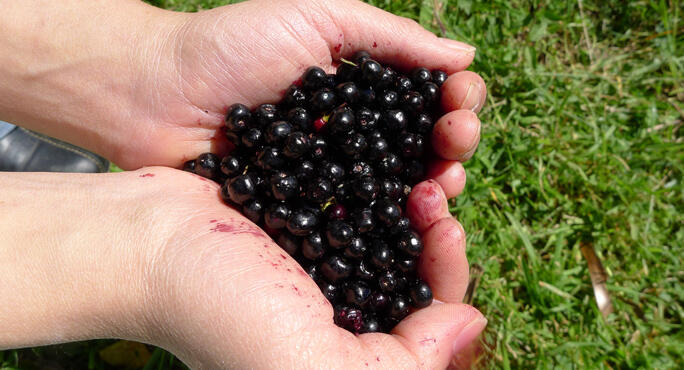Common Name
Botanical Name
By this point, we have been liberally inundated with tales of super fruits, specifically super berries.
Today, practically everyone knows that blueberries, blackberries, black currants, acai, raspberries and elderberries are very good for health. But few have heard of one of the greatest super berries of them all, maqui berry. Recently I traveled to the southern part of Chile, in the Patagonia region, where I experienced maqui berry, the Mapuche native people who harvest the berry, and the majestic Patagonia region where maqui grows profusely in the wild.
Maqui berry (Aristotelia chilensis) is an intensely purple berry that grows wild throughout parts of southern Chile. Along roads and highways, maqui berry bushes are easy to spot. They grow all over hillsides, throughout fields, and on the borders of forested areas. At this point in time, maqui is not cultivated. There is simply so much available in the wild, cultivation is unnecessary
The people who harvest most of the maqui berry sold commercially are the Mapuche indians, who are indigenous to Chile. Known as fierce warriors, the Mapuche are the only native people in the Americas who were not conquered by invading colonists. In southern Chile, I traveled to the area of Maihue’ (pron: my hway), to the hillsides of a pristine lake with the same name, where a community of Mapuche native people harvest tens of tons of wild maqui berry for commercial sale. There I saw, ate, harvested and learned about this remarkable berry, which is making its way into the U.S. marketplace.
The Mapuche people harvest maqui berry in increasingly large quantities, as demand for this nutritious and healing berry has increased. In harvest season, the whole Mapuche community turns out to pick the vibrant purple berries. One thing I discovered is that maqui berries taste delicious. They are sweet, bursting with flavor, and something I would be happy to eat every day. But beyond the marvelous taste, maqui delivers real health benefits. To learn about the health benefits of maqui, I turned to the research of Dr. Juan Hancke, a medical doctor who has devoted several years of intensive research into this super berry.
Here is what is known so far:
Maqui berries are very rich in anthocyanins, which are purple pigments with very high antioxidant activity. Specifically, maqui berries contain high levels of anthocyanins called delphinidins, which is also found in violas, delphiniums, and Concord grapes. But in maqui berry, these compounds are found in unusually high amounts. The delphinidins demonstrate potent anti-inflammatory activity, so they help to reduce the risk of a variety of degenerative diseases that involve inflammation. These pigments also inhibit the growth of colon cancer cells.
Inflammation is part of virtually every degenerative disease, from cardiovascular disease to diabetes to arthritis. Any illness that ends with “itis” is an inflammatory disease. The anthocyanins exhibit powerful anti-inflammatory activity, and do it as well as drugs for the same purposes, without negative effects.
The antioxidant compounds in maqui berry help to prevent the oxidation of cholesterol in the blood. Oxidation of cholesterol is a factor in the development of cardiovascular disease, including heart attack, stroke and hardening of the arteries. Regular daily intake of maqui berries or the berry juice is a smart investment in better cardiovascular health.
Interestingly, intake of maqui berries or their juice causes a significant increase of insulin in the body. In fact, maqui appears to do this better than any other known plant. What does this mean? Consuming maqui berries or their juice with or after meals can help to suppress blood glucose, thereby evening out energy and preventing the formation of new fat cells. As a result, maqui may prove to be a beneficial aid in weight control.
Maqui also demonstrates antibacterial activity, which suggests that it may aid in preventing illness due to foodborne germs.
The Mapuche native people have been eating maqui berries and drinking their juice for centuries. And other non-native people in Chile have done the same for a very long time as well. Even in an environment in which the maret is literally flooded with so-called super fruits, maqui stands head and shoulders above most of them in terms of benefits.
By Chris Kilham, for Fox News Health
You can find Maqui products at Whole Foods and other Independent Retailers, as well as online.


